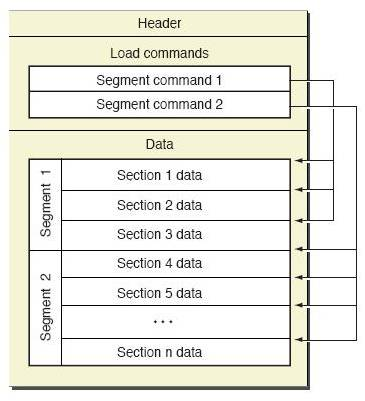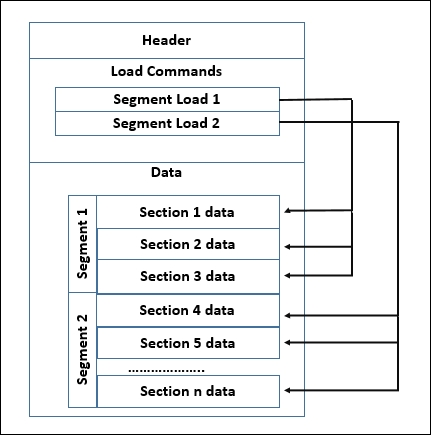16 KiB
macOS Universal binaries & Mach-O Format
Learn AWS hacking from zero to hero with htARTE (HackTricks AWS Red Team Expert)!
Other ways to support HackTricks:
- If you want to see your company advertised in HackTricks or download HackTricks in PDF Check the SUBSCRIPTION PLANS!
- Get the official PEASS & HackTricks swag
- Discover The PEASS Family, our collection of exclusive NFTs
- Join the 💬 Discord group or the telegram group or follow us on Twitter 🐦 @carlospolopm.
- Share your hacking tricks by submitting PRs to the HackTricks and HackTricks Cloud github repos.
Basic Information
Mac OS binaries usually are compiled as universal binaries. A universal binary can support multiple architectures in the same file.
These binaries follows the Mach-O structure which is basically compased of:
- Header
- Load Commands
- Data
Fat Header
Search for the file with: mdfind fat.h | grep -i mach-o | grep -E "fat.h$"
#define FAT_MAGIC 0xcafebabe
#define FAT_CIGAM 0xbebafeca /* NXSwapLong(FAT_MAGIC) */
struct fat_header {
uint32_t magic; /* FAT_MAGIC or FAT_MAGIC_64 */
uint32_t nfat_arch; /* number of structs that follow */
};
struct fat_arch {
cpu_type_t cputype; /* cpu specifier (int) */
cpu_subtype_t cpusubtype; /* machine specifier (int) */
uint32_t offset; /* file offset to this object file */
uint32_t size; /* size of this object file */
uint32_t align; /* alignment as a power of 2 */
};
The header has the magic bytes followed by the number of archs the file contains (nfat_arch) and each arch will have a fat_arch struct.
Check it with:
% file /bin/ls
/bin/ls: Mach-O universal binary with 2 architectures: [x86_64:Mach-O 64-bit executable x86_64] [arm64e:Mach-O 64-bit executable arm64e]
/bin/ls (for architecture x86_64): Mach-O 64-bit executable x86_64
/bin/ls (for architecture arm64e): Mach-O 64-bit executable arm64e
% otool -f -v /bin/ls
Fat headers
fat_magic FAT_MAGIC
nfat_arch 2
architecture x86_64
cputype CPU_TYPE_X86_64
cpusubtype CPU_SUBTYPE_X86_64_ALL
capabilities 0x0
offset 16384
size 72896
align 2^14 (16384)
architecture arm64e
cputype CPU_TYPE_ARM64
cpusubtype CPU_SUBTYPE_ARM64E
capabilities PTR_AUTH_VERSION USERSPACE 0
offset 98304
size 88816
align 2^14 (16384)
or using the Mach-O View tool:
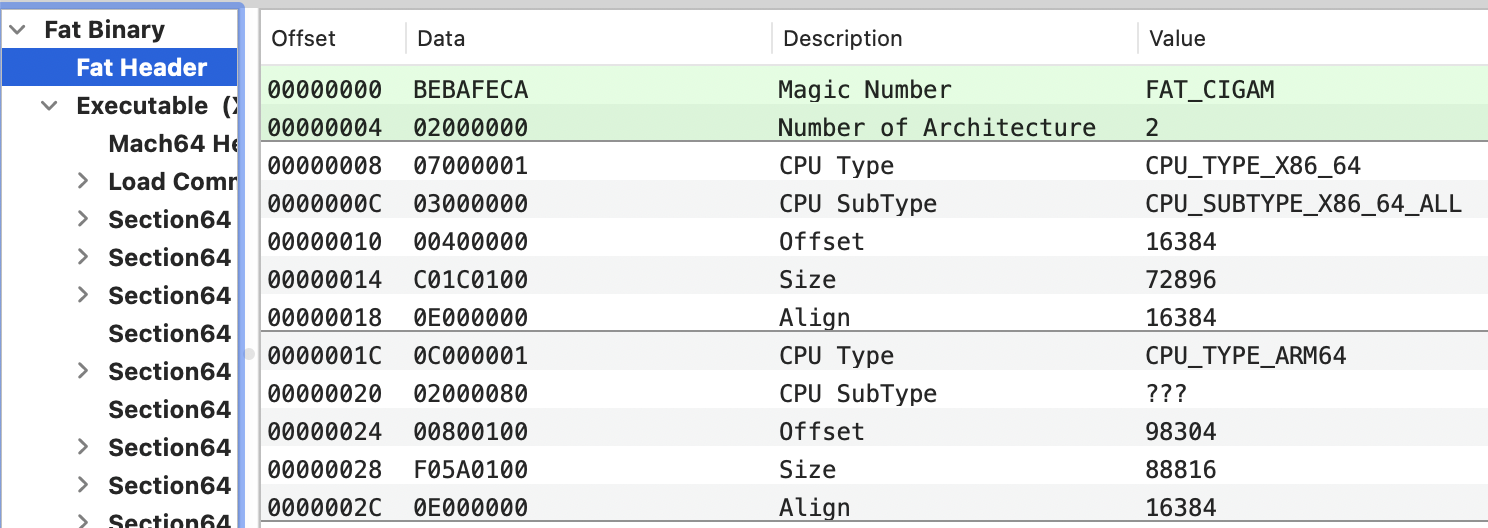
As you may be thinking usually a universal binary compiled for 2 architectures doubles the size of one compiled for just 1 arch.
Mach-O Header
The header contains basic information about the file, such as magic bytes to identify it as a Mach-O file and information about the target architecture. You can find it in: mdfind loader.h | grep -i mach-o | grep -E "loader.h$"
#define MH_MAGIC 0xfeedface /* the mach magic number */
#define MH_CIGAM 0xcefaedfe /* NXSwapInt(MH_MAGIC) */
struct mach_header {
uint32_t magic; /* mach magic number identifier */
cpu_type_t cputype; /* cpu specifier (e.g. I386) */
cpu_subtype_t cpusubtype; /* machine specifier */
uint32_t filetype; /* type of file (usage and alignment for the file) */
uint32_t ncmds; /* number of load commands */
uint32_t sizeofcmds; /* the size of all the load commands */
uint32_t flags; /* flags */
};
#define MH_MAGIC_64 0xfeedfacf /* the 64-bit mach magic number */
#define MH_CIGAM_64 0xcffaedfe /* NXSwapInt(MH_MAGIC_64) */
struct mach_header_64 {
uint32_t magic; /* mach magic number identifier */
int32_t cputype; /* cpu specifier */
int32_t cpusubtype; /* machine specifier */
uint32_t filetype; /* type of file */
uint32_t ncmds; /* number of load commands */
uint32_t sizeofcmds; /* the size of all the load commands */
uint32_t flags; /* flags */
uint32_t reserved; /* reserved */
};
Filetypes:
- MH_EXECUTE (0x2): Standard Mach-O executable
- MH_DYLIB (0x6): A Mach-O dynamic linked library (i.e. .dylib)
- MH_BUNDLE (0x8): A Mach-O bundle (i.e. .bundle)
# Checking the mac header of a binary
otool -arch arm64e -hv /bin/ls
Mach header
magic cputype cpusubtype caps filetype ncmds sizeofcmds flags
MH_MAGIC_64 ARM64 E USR00 EXECUTE 19 1728 NOUNDEFS DYLDLINK TWOLEVEL PIE
Or using Mach-O View:
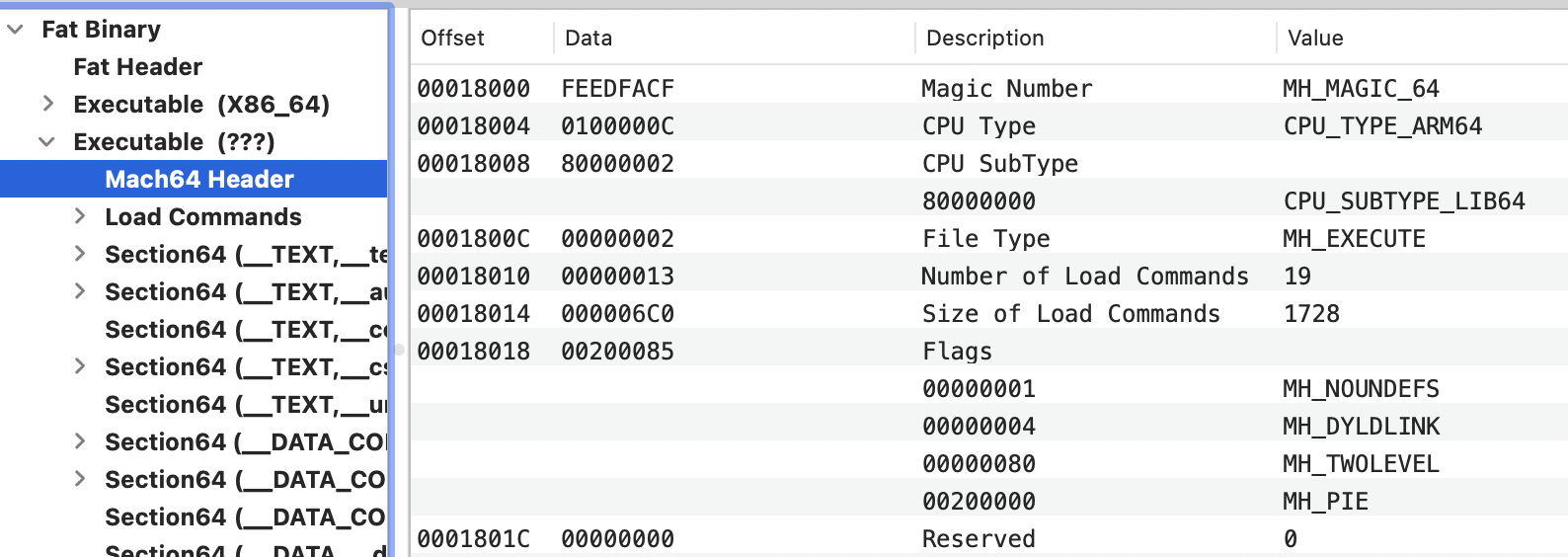
Mach-O Load commands
The file's layout in memory is specified here, detailing the symbol table's location, the context of the main thread at execution start, and the required shared libraries. Instructions are provided to the dynamic loader (dyld) on the binary's loading process into memory.
The uses the load_command structure, defined in the mentioned loader.h:
struct load_command {
uint32_t cmd; /* type of load command */
uint32_t cmdsize; /* total size of command in bytes */
};
There are about 50 different types of load commands that the system handles differently. The most common ones are: LC_SEGMENT_64, LC_LOAD_DYLINKER, LC_MAIN, LC_LOAD_DYLIB, and LC_CODE_SIGNATURE.
LC_SEGMENT/LC_SEGMENT_64
{% hint style="success" %} Basically, this type of Load Command define how to load the __TEXT (executable code) and __DATA (data for the process) segments according to the offsets indicated in the Data section when the binary is executed. {% endhint %}
These commands define segments that are mapped into the virtual memory space of a process when it is executed.
There are different types of segments, such as the __TEXT segment, which holds the executable code of a program, and the __DATA segment, which contains data used by the process. These segments are located in the data section of the Mach-O file.
Each segment can be further divided into multiple sections. The load command structure contains information about these sections within the respective segment.
In the header first you find the segment header:
struct segment_command_64 { /* for 64-bit architectures */
uint32_t cmd; /* LC_SEGMENT_64 */
uint32_t cmdsize; /* includes sizeof section_64 structs */
char segname[16]; /* segment name */
uint64_t vmaddr; /* memory address of this segment */
uint64_t vmsize; /* memory size of this segment */
uint64_t fileoff; /* file offset of this segment */
uint64_t filesize; /* amount to map from the file */
int32_t maxprot; /* maximum VM protection */
int32_t initprot; /* initial VM protection */
uint32_t nsects; /* number of sections in segment */
uint32_t flags; /* flags */
};
Example of segment header:

This header defines the number of sections whose headers appear after it:
struct section_64 { /* for 64-bit architectures */
char sectname[16]; /* name of this section */
char segname[16]; /* segment this section goes in */
uint64_t addr; /* memory address of this section */
uint64_t size; /* size in bytes of this section */
uint32_t offset; /* file offset of this section */
uint32_t align; /* section alignment (power of 2) */
uint32_t reloff; /* file offset of relocation entries */
uint32_t nreloc; /* number of relocation entries */
uint32_t flags; /* flags (section type and attributes)*/
uint32_t reserved1; /* reserved (for offset or index) */
uint32_t reserved2; /* reserved (for count or sizeof) */
uint32_t reserved3; /* reserved */
};
Example of section header:
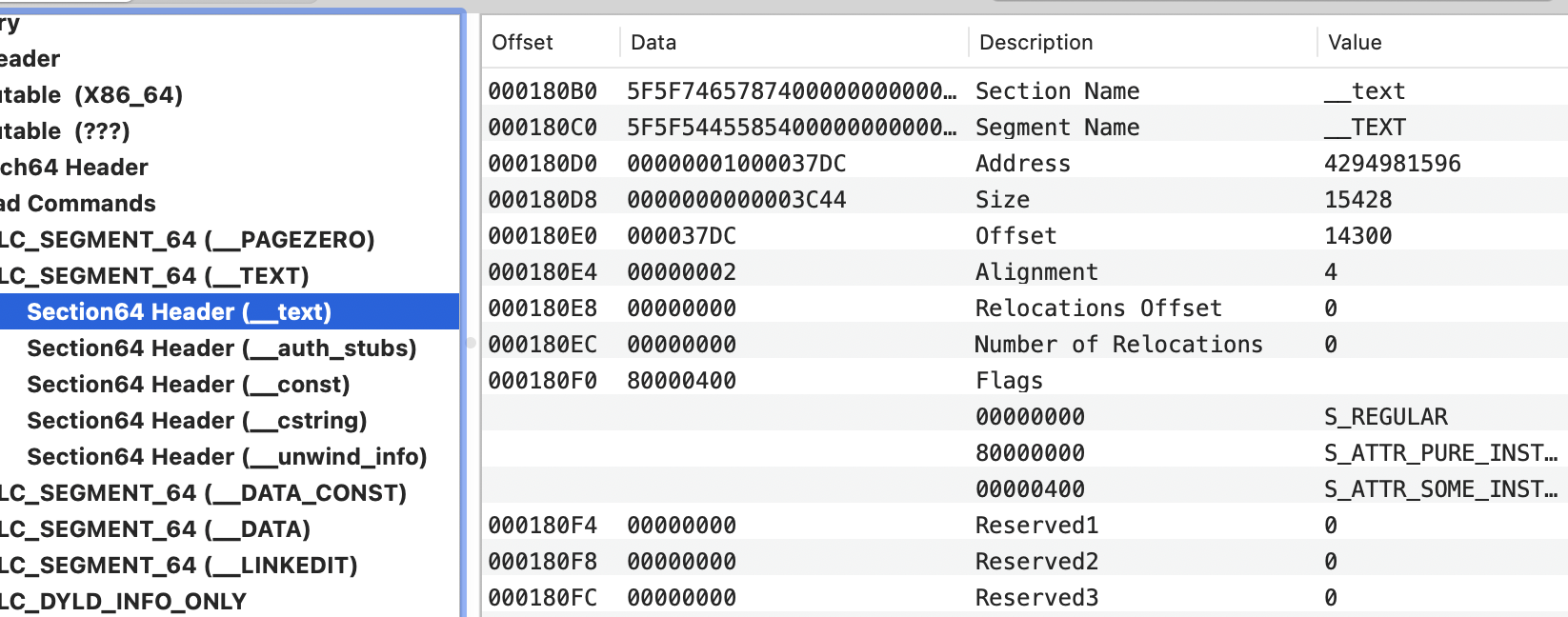
If you add the section offset (0x37DC) + the offset where the arch starts, in this case 0x18000 --> 0x37DC + 0x18000 = 0x1B7DC

It's also possible to get headers information from the command line with:
otool -lv /bin/ls
Common segments loaded by this cmd:
__PAGEZERO: It instructs the kernel to map the address zero so it cannot be read from, written to, or executed. The maxprot and minprot variables in the structure are set to zero to indicate there are no read-write-execute rights on this page.- This allocation is important to mitigate NULL pointer dereference vulnerabilities.
__TEXT: Contains executable code with read and execute permissions (no writable). Common sections of this segment:__text: Compiled binary code__const: Constant data__cstring: String constants__stubsand__stubs_helper: Involved during the dynamic library loading process
__DATA: Contains data that is readable and writable (no executable).__data: Global variables (that have been initialized)__bss: Static variables (that have not been initialized)__objc_*(__objc_classlist, __objc_protolist, etc): Information used by the Objective-C runtime
__LINKEDIT: Contains information for the linker (dyld) such as, "symbol, string, and relocation table entries."__OBJC: Contains information used by the Objective-C runtime. Though this information might also be found in the __DATA segment, within various in __objc_* sections.
LC_MAIN
Contains the entrypoint in the entryoff attribute. At load time, dyld simply adds this value to the (in-memory) base of the binary, then jumps to this instruction to start execution of the binary’s code.
LC_CODE_SIGNATURE
Contains information about the code signature of the Macho-O file. It only contains an offset that points to the signature blob. This is typically at the very end of the file.
However, you can find some information about this section in this blog post and this gists.
LC_LOAD_DYLINKER
Contains the path to the dynamic linker executable that maps shared libraries into the process address space. The value is always set to /usr/lib/dyld. It’s important to note that in macOS, dylib mapping happens in user mode, not in kernel mode.
LC_LOAD_DYLIB
This load command describes a dynamic library dependency which instructs the loader (dyld) to load and link said library. There is a LC_LOAD_DYLIB load command for each library that the Mach-O binary requires.
- This load command is a structure of type
dylib_command(which contains a struct dylib, describing the actual dependent dynamic library):
struct dylib_command {
uint32_t cmd; /* LC_LOAD_{,WEAK_}DYLIB */
uint32_t cmdsize; /* includes pathname string */
struct dylib dylib; /* the library identification */
};
struct dylib {
union lc_str name; /* library's path name */
uint32_t timestamp; /* library's build time stamp */
uint32_t current_version; /* library's current version number */
uint32_t compatibility_version; /* library's compatibility vers number*/
};
You could also get this info from the cli with:
otool -L /bin/ls
/bin/ls:
/usr/lib/libutil.dylib (compatibility version 1.0.0, current version 1.0.0)
/usr/lib/libncurses.5.4.dylib (compatibility version 5.4.0, current version 5.4.0)
/usr/lib/libSystem.B.dylib (compatibility version 1.0.0, current version 1319.0.0)
Some potential malware related libraries are:
- DiskArbitration: Monitoring USB drives
- AVFoundation: Capture audio and video
- CoreWLAN: Wifi scans.
{% hint style="info" %}
A Mach-O binary can contain one or more constructors, that will be executed before the address specified in LC_MAIN.
The offsets of any constructors are held in the __mod_init_func section of the __DATA_CONST segment.
{% endhint %}
Mach-O Data
At the core of the file lies the data region, which is composed of several segments as defined in the load-commands region. A variety of data sections can be housed within each segment, with each section holding code or data specific to a type.
{% hint style="success" %} The data is basically the part containing all the information that is loaded by the load commands LC_SEGMENTS_64 {% endhint %}
This includes:
- Function table: Which holds information about the program functions.
- Symbol table: Which contains information about the external function used by the binary
- It could also contain internal function, variable names as well and more.
To check it you could use the Mach-O View tool:
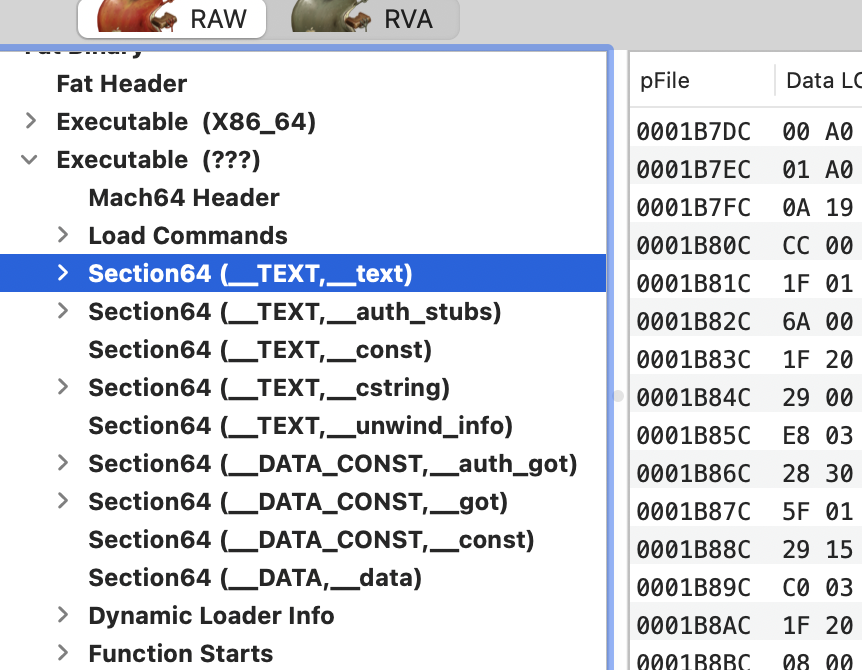
Or from the cli:
size -m /bin/ls
Learn AWS hacking from zero to hero with htARTE (HackTricks AWS Red Team Expert)!
Other ways to support HackTricks:
- If you want to see your company advertised in HackTricks or download HackTricks in PDF Check the SUBSCRIPTION PLANS!
- Get the official PEASS & HackTricks swag
- Discover The PEASS Family, our collection of exclusive NFTs
- Join the 💬 Discord group or the telegram group or follow us on Twitter 🐦 @carlospolopm.
- Share your hacking tricks by submitting PRs to the HackTricks and HackTricks Cloud github repos.
